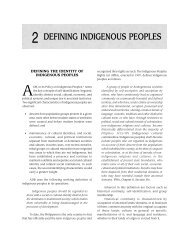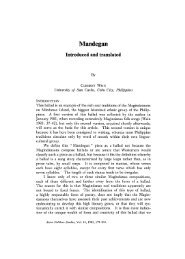Filipino Proper Manners and Etiquette - Philippine Culture
Filipino Proper Manners and Etiquette - Philippine Culture
Filipino Proper Manners and Etiquette - Philippine Culture
- No tags were found...
Create successful ePaper yourself
Turn your PDF publications into a flip-book with our unique Google optimized e-Paper software.
<strong>Filipino</strong> <strong>Proper</strong> <strong>Manners</strong><strong>and</strong> <strong>Etiquette</strong>
What is <strong>Manners</strong>?What is <strong>Manners</strong>?In sociology, manners are the unenforced st<strong>and</strong>ards ofconduct which demonstrate that a person is proper, polite,<strong>and</strong> refined. They are like laws in that they codify or set ast<strong>and</strong>ard for human behavior, but, unlike laws, there is noformal system for punishing transgressions, the main informal"punishment" being social disapproval. A lady is a termfrequently used for a woman who follows proper manners; theterm gentleman is used as a male counterpart; though theseterms are also often used for members of a particular socialclass.
What is <strong>Etiquette</strong>?<strong>Etiquette</strong> is a code of behavior that delineatesexpectations for social behavior according to contemporaryconventional norms within a society, social class, or group.Rules of etiquette encompass most aspects of social interactionin any society, though the term itself is not commonly used. Arule of etiquette may reflect an underlying ethical code or itmay reflect a person's fashion or status. Rules of etiquette areusually unwritten, but aspects of etiquette have been codifiedfrom time to time.
History Of <strong>Etiquette</strong>
History Of <strong>Etiquette</strong>
History Of <strong>Etiquette</strong>
Social <strong>Etiquette</strong>
Social <strong>Etiquette</strong>• <strong>Filipino</strong>s hold gentlemanly etiquette in high regard.• When attending a funeral, avoid wearing loud colors.• <strong>Filipino</strong>s place importance on proper introductions.• Always acknowledge the presence of older people in the roomby shaking their h<strong>and</strong>s• Never address older people at the same level.• When speaking to elders, be respectful in tone <strong>and</strong> language.• It is expected that guests are to be lively <strong>and</strong> take part in theconversation• During social gatherings, the elderly are usually greeted first.• Boisterous or loud talking is generally frowned upon.
Social <strong>Etiquette</strong>• If someone needs to walk in front of the TV or between two people, heor she must say "Excuse me" .• When one person meets an acquaintance at any form of publictransport, he/she must never forget to greet him/her.• In the <strong>Philippine</strong>s, kissing <strong>and</strong> displaying affection in public is consideredsc<strong>and</strong>alous <strong>and</strong> in bad taste.• If you happen to visit a friend, you'll notice that the shoes are leftoutside or placed in a shoe holder of some kind• In gratitude of an invitation to a home or an occasion, <strong>Filipino</strong>sappreciate guests bringing a fruit basket or any food.• Some <strong>Filipino</strong>s simply nod their head once when saying yes instead ofsaying it.• A h<strong>and</strong>shake or a smile is the general norm of greeting in <strong>Philippine</strong>s
Business <strong>Etiquette</strong>• Punctuality is not of the utmost importance in the <strong>Philippine</strong>s, <strong>and</strong> neither isthe concept of an RSVP.• There may be several minutes of small talk before getting down to business.• Start out by addressing a new business acquaintance by his or her familyname.• Wait to be told where to sit.• <strong>Filipino</strong>s avoid confrontation if possible.• An integral part of culture <strong>and</strong> values is hospitality.• <strong>Filipino</strong>s observe a wide range of grooming styles.• <strong>Filipino</strong>s are basically hygienic.• Many of the business practices are anchored on the Catholic religion <strong>and</strong>various ancient superstition.• When greeting business partners, a firm <strong>and</strong> brisk h<strong>and</strong>shake is good with awarm smile on your face.
Dining <strong>Etiquette</strong>
Dining <strong>Etiquette</strong>• For parties, arriving 15-20 minutes late is commonly known as"<strong>Filipino</strong> time".• Follow dress codes, <strong>and</strong> groom yourself.• <strong>Filipino</strong>s like to entertain.• Wherever you travel in the <strong>Philippine</strong>s, you’re sure to comeacross a turo turo (literally translated as ‘point-point’).• Do not take the last bit of food from a central serving plate ifthere is one .• Toothpicks are often used at the end of the meal.• The most honored position is at the head of the table.
Dining <strong>Etiquette</strong>• When chancing upon a <strong>Filipino</strong> eating, he would invite the visitorby inviting him to eat.• <strong>Filipino</strong>s may view a dinner/party invitation as just a passingthought.• Toasts are common in the <strong>Philippine</strong>s, especially at businessmeetings.• Usually the one who does the inviting pays the bill, although theguest is expected to make an effort to pay.• At the end of the meal, you may be given pabaon.• Hosts will invariably lay out a snack for their visitors.
Gift Giving <strong>Etiquette</strong>
Gift Giving <strong>Etiquette</strong>• Gift giving is important on many occasions such as weddings <strong>and</strong> birthdays• Once a contract has been signed, prepare to give your new partners a gift ofgreater value.• When selecting wrapping paper for a <strong>Filipino</strong> recipient, you may use anycolor you wish• When invited to a <strong>Filipino</strong> home, bring a gift of flowers, c<strong>and</strong>y or chocolates.• At Christmas, you will be expected to give a small, modest gift to practicallyeveryone you encounter in a business context.• When you receive a gift, follow the Asian custom by not opening it in frontof the giver.• During certain family events, particularly baptisms, it is customary to toss ah<strong>and</strong>ful of small coins to any children present.• At weddings, guests will sometimes use pins to attach money--typically billsin small denominations--to the clothing of the bride <strong>and</strong> groom.
















